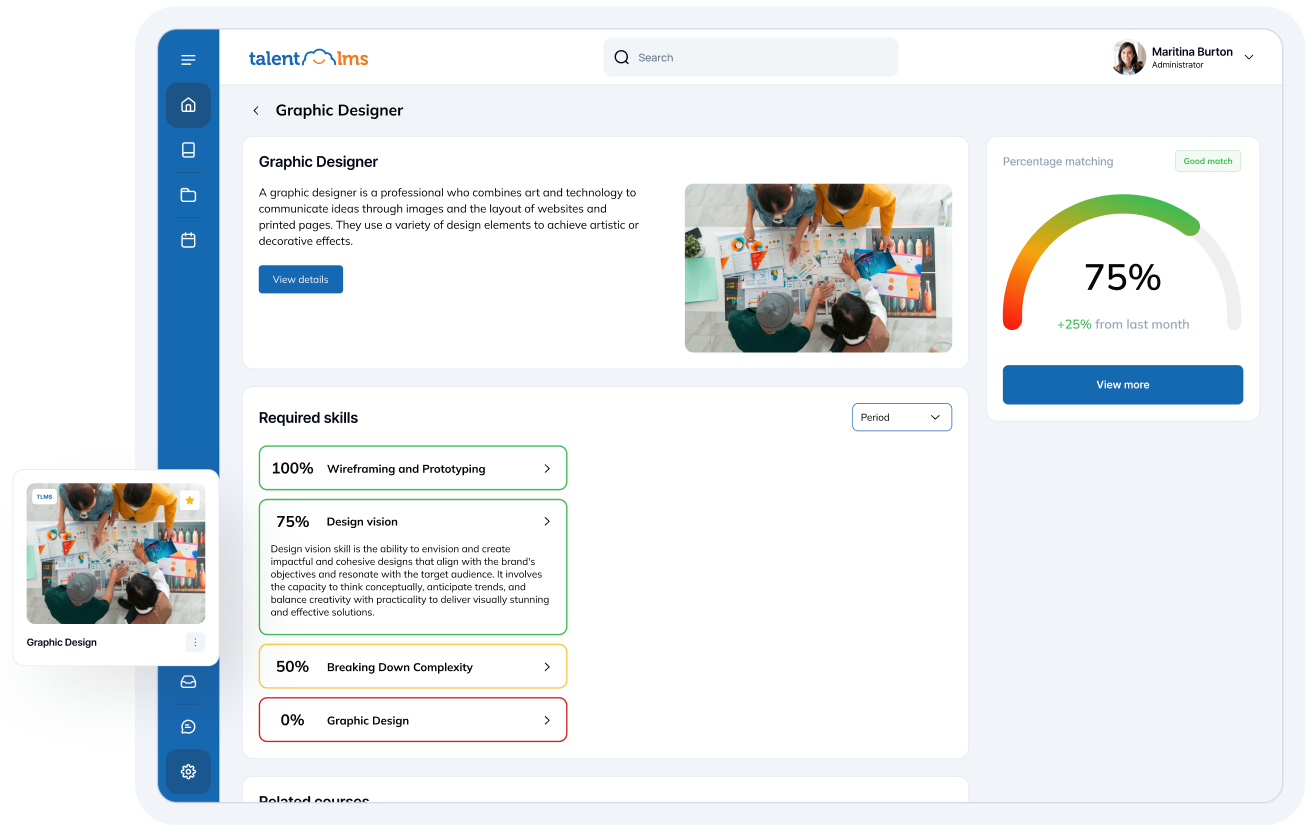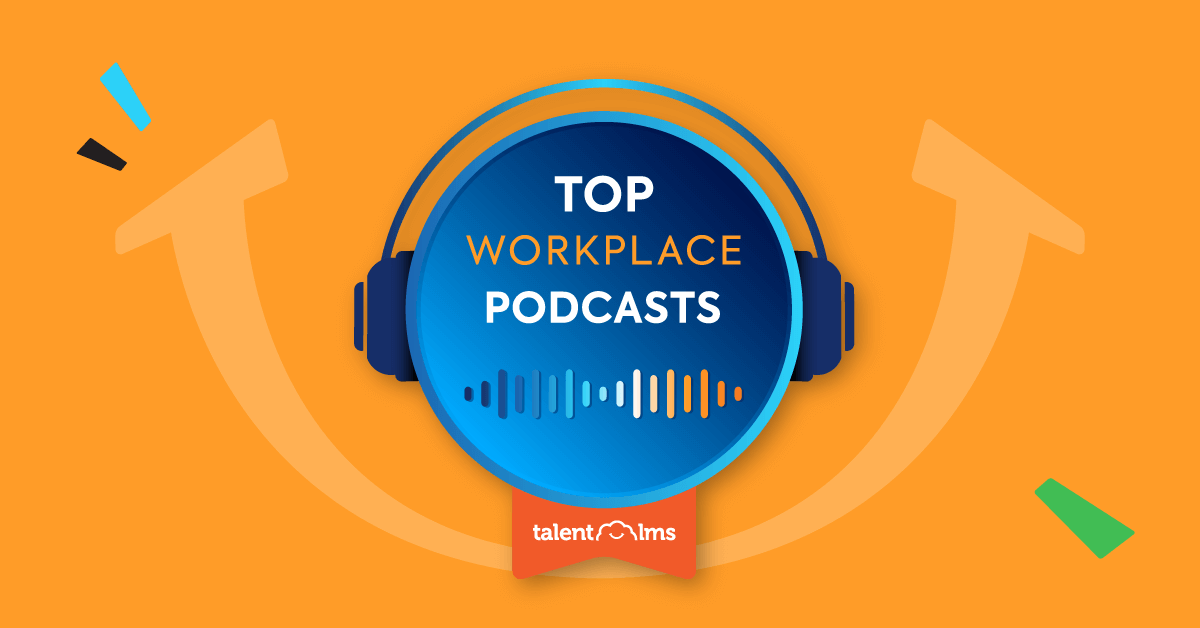- What’s the difference between upskilling & reskilling employees?
- What are the benefits of an employee upskilling & reskilling strategy?
- Upskilling and reskilling vs. external hiring
- Which are the most popular skills for upskilling and reskilling programs?
- Employee upskilling and reskilling challenges
- Crafting effective skilling training programs
- Why upskilling & reskilling are now more important than ever
The need for new skills grows rapidly in today’s fast-paced work environment.
Enter upskilling and reskilling. The invaluable game-changers for employees and employers, which set them ready for future success.
In this article, we’ll explore the difference between upskilling and reskilling, the key benefits of an upskilling and reskilling strategy, its impact on employee retention, and tips for successful implementation.
What’s the difference between upskilling & reskilling employees?
Both upskilling and reskilling are vital strategies for employees and their development in the modern business landscape. And even though they both address skills gaps, they serve different purposes.
Upskilling employees involves training new skills or bridging skills gaps within existing roles. The focus is on boosting their abilities to perform more effectively in their current roles while keeping up with advancements in their field. For instance, HR teams learning about new employee retention strategies is considered upskilling.
Reskilling employees, on the other hand, involves training employees to take on new roles or acquiring new, advanced skills. This comes in handy when a current role is no longer needed or when a shift in company strategy requires different skill sets. For example, a marketing specialist learning coding to transition into an IT role is considered reskilling.
In brief, upskilling employees means employees expand their current skill set, while reskilling involves broadening their skill set to pivot to an entirely new role. All in all, both are necessary to create a dynamic and adaptable workforce.

What are the benefits of an employee upskilling & reskilling strategy?
Implementing a robust upskilling and reskilling strategy offers various benefits to both employees and organizations. Here are some key benefits of upskilling and reskilling:
For employees
A career path full of growth and development
When people learn new skills or improve their current ones, they open doors to promotions and job opportunities within the organization. Think of it as adding more tools to their toolbox, making them more versatile and ready for bigger challenges.
Job security
37% of employees worry that their skills will become outdated. However, for 64%, upskilling and reskilling boost their job security. Reskilling and upskilling employees mean their skills stay relevant and valuable to the company. This means they can protect their jobs even if the industry changes or new tech emerges.
Increased job satisfaction
Continuous learning and career growth make work more exciting and rewarding for individuals. Employees feel more accomplished and fulfilled when they see real progress in their careers.
Adaptability
Without continuous learning, employees risk becoming outdated. Sagar Goel highlights in “The building blocks of successful employee reskilling” from TalentLMS’s podcast series, Keep it Simple, how adaptability through ongoing skill development is crucial.
Employees who are continuously learning new skills can adapt more quickly to changes in their roles or the industry. With the right skills, they are more flexible and able to handle new responsibilities and identify opportunities for career progression.
For organizations
Increased productivity
Highly skilled employees perform more efficiently and effectively in their roles. Meaning, they can get more done in less time, boosting overall productivity and helping the company achieve its goals faster.
Innovation and competitiveness
77% of employees agree that learning new skills gives them a sense of purpose. A workforce that’s always learning is more likely to develop new ideas and solutions. This boosts innovation plus keeps the company ahead of the competition.
Employee retention
A company that invests in career growth, specifically through dedicated employee development plans, shows they value and appreciate their employees. This reduces employee turnover and the costs associated with hiring and training new employees.
Also, involving employees as partners in their development fosters loyalty and improves retention rates. Goel mentions, “One of the best practices of reskilling done well is when you treat your employee as a partner. Meaning, to co-create and co-run these programs along with the employees. This helps make the ‘why’ (of reskilling) clear.” Plus, he states that if organizations want to “win” the “war of talent,” they must invest in upskilling and reskilling to attract and retain the best employees.
Talent acquisition
Companies known for their commitment to employee development attract qualified talent. But, that’s not all. They can also dip into their existing talent pool and offer employees opportunities for internal mobility. Offering growth opportunities to the right employees is in itself a learning experience.
Resilience and agility
A workforce with a diverse skill set means a company that can better handle disruptions (be it tech changes, economic shifts, or other industry-specific challenges.) This agility helps companies navigate tough times more smoothly.
Cost savings
Training existing employees to take on new roles or improve in their current ones is less expensive that hiring new people. This saves money spent on recruitment, onboarding, and initial training, making the organization more cost-effective.
Upskilling and reskilling vs. external hiring
To build a strong workforce, it’s a strategic imperative to weigh the benefits of upskilling and reskilling current employees vs hiring new talent.
Upskilling and reskilling
An upskilling program (or reskilling one) is extremely cost-effective as training the existing workforce saves on recruiting and onboarding costs. Also, it’s faster to integrate. Current employees already have a good understanding of the organizational culture and processes. Moreover, upskilling and reskilling promote a learning culture that encourages continuous innovation and adaptability.
However, training initiatives can be time-consuming and do not always succeed in bridging specific skills gaps.
External hiring
Hiring new people can bring the organization immediate expertise. New hires bring in fresh skills and perspectives, filling skills gaps quickly. Also, having access to top talent and innovative ideas gives your company a competitive edge.
On the other hand, the external hiring process can be costly. And new employees might need more time to adapt to the company culture than your existing employees.
Overall, a balanced approach ensures a dynamic and competitive workforce ready to meet future challenges. So, the best thing for organizations to consider is combining upskilling and reskilling with strategic external hiring.
Which are the most popular skills for upskilling and reskilling programs?
Here are some of the most popular skills that employees often need for upskilling and reskilling development programs. These can be either technical skills or soft skills:
Digital literacy
- Data analysis and interpretation for making data-driven decisions
- Digital marketing, including social media management and SEO
- Cybersecurity to be able to protect digital information and keep data integrity
Technological proficiency
- Coding and programming, including languages like Python, Java, and JavaScript
- Software training to be able to make full use of the latest digital tools
- AI, automation technologies, and machine learning to be able to automate processes

Meet TalentLibrary™
A growing collection of ready-made courses that cover the soft skills
your teams need for success at work![]()

Soft skills
- Emotional intelligence to boost communication and leadership expertise
- Adaptability and resilience are essential for creating an agile workforce
- Critical thinking skills and problem-solving are essential across all industries and departments
Leadership and management
- Project management to plan and execute projects
- Change management for an agile workforce and creating the future business leaders
Additional skills
- Financial literacy is important for budgeting and financial planning
- Sales, negotiation, and customer service to boost customer satisfaction and business development
Employee upskilling and reskilling challenges
Upskilling and reskilling also come with challenges. Which can make the employee skilling journey a rather daunting one.
Recognizing them is the first step in navigating the path to personal and professional growth.
Time management
Finding the time to learn new skills can be a big hurdle. Think about a full-time employee with family commitments trying to squeeze in a coding class or a marketing seminar. Balancing work, personal life, and training often feels like juggling too many balls in the air.
Access to resources
Not everyone has the same chance to access training materials. People in rural areas might have to travel long distances to attend training centers, which takes time and money. Without a company budget for training, the cost can be too high for some. These challenges can limit opportunities for learning and growth.
Staying motivated
Keeping up the motivation to learn something new isn’t always easy. Usually, people start a new course with enthusiasm. But keeping that drive through hard-to-grasp topics or making slow progress are rather challenging. Imagine hitting a wall while learning a new coding language, and suddenly, your daily tasks look more appealing.
Skill relevance
The job market is always changing. So it can be hard to predict which skills will be in demand. Most upskilling and reskilling programs lack the skills the workforce needs. And people might invest time in learning a particular skill, only to find out short after that it’s no longer relevant.
Goel supports, “Where I see reskilling not done well is because it’s not focusing on some of the core critical skills, some of the soft skills […] They are always the hardest, yet the other ones drive the most impact.” Focusing on high-impact skills and failing to do so can undermine reskilling initiatives.
Overcoming fear and uncertainty
The fear of the unknown can be paralyzing. Employees worry about failing or not being good enough. And that’s especially true when they need to switch to a completely different field. This fear can block employees and prevent them from even starting the learning process.
Quality of training
Not all training programs are effective. Some may promise a lot but deliver little in terms of practical knowledge. Investing time in low-quality training courses can be frustrating and demoralizing, leading to a sense of wasted effort.
Crafting effective skilling training programs
Creating an effective skilling training program involves several key components you shouldn’t miss. In fact, according to Goel, reskilling takes a village. Let’s explore how to craft a compelling and engaging reskilling and upskilling program that’s aligned with both employee and business needs.
Analyze employee skills based on data and insights
Data is your superpower for getting a clear picture of your employees’ current skill set. A skills gap analysis can help identify skills gaps and areas for improvement. A data-driven approach ensures that your reskilling and upskilling program is targeted, relevant, and effective. Think of it as using a map for a journey. You need to know where you are to follow the best course to your destination.
Embrace personalized learning
Personalized learning is like tailoring a suit. It fits perfectly because it considers all the details.
When designing a reskilling or upskilling program, consider factors such as age, skill level, aspirations, and interests. For example, a younger employee might be more tech-savvy and interested in using digital tools. While a seasoned employee might excel in strategic planning. Aligning these personal attributes with business needs ensures the training is relevant and engaging.
Allow time within the workday for upskilling and reskilling
Expecting employees to find extra hours outside of their workday for training is unrealistic and often counterproductive. Incorporate training time into their work schedule to acknowledge its importance. Think of it as an investment in your team’s professional development, just like any other business activity.
Combat content overload
If you want your training to be effective and engaging, avoid overwhelming employees with too much information at once. Use microlearning to break down content into bite-sized chunks that are easier to digest. Also, consider on-the-job learning opportunities where employees can apply new skills in real time. Last, use both synchronous and asynchronous learning to cater to different learning styles and schedules.
Understand the power of peers
Learning is often more effective in a social context. Encourage peer-to-peer learning for upskilling and reskilling so that employees can share knowledge and experiences. This boosts understanding and builds a collaborative culture. For instance, set up study groups or team projects to leverage your workforce’s collective expertise.
Provide job shadowing, mentoring, and role-playing
Hands-on training, such as job shadowing, mentoring, and role-playing, is invaluable. Job shadowing allows people to learn directly from more experienced colleagues, providing insights often missed in formal training. Mentoring builds strong relationships and makes the transfer of knowledge easier. Role-playing prepares employees for real-world scenarios, boosting their confidence and problem-solving skills.
Invest in continuous training
Skilling isn’t a one-and-done event. Instead, it’s a continuous process. Regularly update training programs to reflect new trends and technologies. This ongoing commitment allows employees to stay ahead of the curve and continuously improve their skills. It’s like maintaining a garden—regular care and updates ensure it flourishes.
Succeed with the right technology
Choosing the right tools is vital for the success of your training program. Platforms like TalentLMS can streamline the learning process, offering a centralized hub for training materials, tracking progress, and facilitating communication. Good tech makes training more accessible, efficient, and effective.
Foster a learning culture
Creating a culture that values continuous learning and development is essential. Leadership must show their commitment to learning, recognize and reward processes, and encourage curiosity and innovation. A supportive environment where people feel safe to take risks and learn from mistakes boosts employee engagement and effectiveness. To achieve this, consider creating personalized employee development plans for your employees.
Set clear goals and metrics
Clearly defined goals and metrics are necessary to measure the success of your skilling training program. Establish what you want to achieve from the beginning. Is this improving specific skills? Enhancing employee productivity? Or prepare employees for new roles?
Then, use metrics to track progress and make data-driven adjustments to your training program.
Focus on employee feedback
Seek regular feedback from learners to understand what’s working and what isn’t. This can be done through surveys, focus groups, and even informal check-ins. Feedback allows an organization to refine upskilling and reskilling initiatives and ensure they meet the employees’ needs.
Encourage self-directed learning
Self-directed learning fosters autonomy and motivation. Empower employees to take charge of their own learning. Offer access to various resources, such as online courses, seminars, and more, and encourage them to pursue topics that are relevant and interesting.
Ensure inclusivity and accessibility
It’s essential to make sure your skilling training is inclusive and accessible to all, regardless of their background, abilities, or learning preferences. This could involve providing material in different formats, offering language support, covering travel expenses, or ensuring that digital platforms are accessible to people with disabilities.
Align training with organizational strategy
Aligning your reskilling and upskilling programs with broader organizational goals will help you gain buy-in from senior leadership. Plus, it will ensure that the skills being developed are the ones to drive the organization forward.
Closely monitor industry trends
Stay updated with the latest industry trends to keep your reskilling and upskilling programs relevant. This helps anticipate future skills needs and adjust training proactively. Plus, networking with industry peers and experts or attending conferences provides valuable insights.
Promote cross-departmental collaboration
Encourage collaboration across different departments within the organization. This broadens the employee skill sets and fosters a more integrated and cohesive workplace. Cross-functional projects and rotations provide valuable reskilling and upskilling opportunities and experiences.
Why upskilling & reskilling are now more important than ever
Upskilling and reskilling are essential for both individuals and businesses in today’s fast-paced environment filled with new challenges.
With AI and new technologies rapidly changing the workplace, you need to future-proof your workforce by staying relevant and continuously learning new skills. For employees, it’s all about career progression and job security. For businesses, it’s the key to innovation and staying competitive.
Now, more than ever, investing in skill development will pave the way for a prosperous and dynamic workplace filled with top talent—and that’s the ticket to sustainable growth and success.
| Tags: learning and development,reskilling,upskilling,upskilling and reskilling





